The Lincoln Memorial Shrine in Redlands memorializes Honest Abe
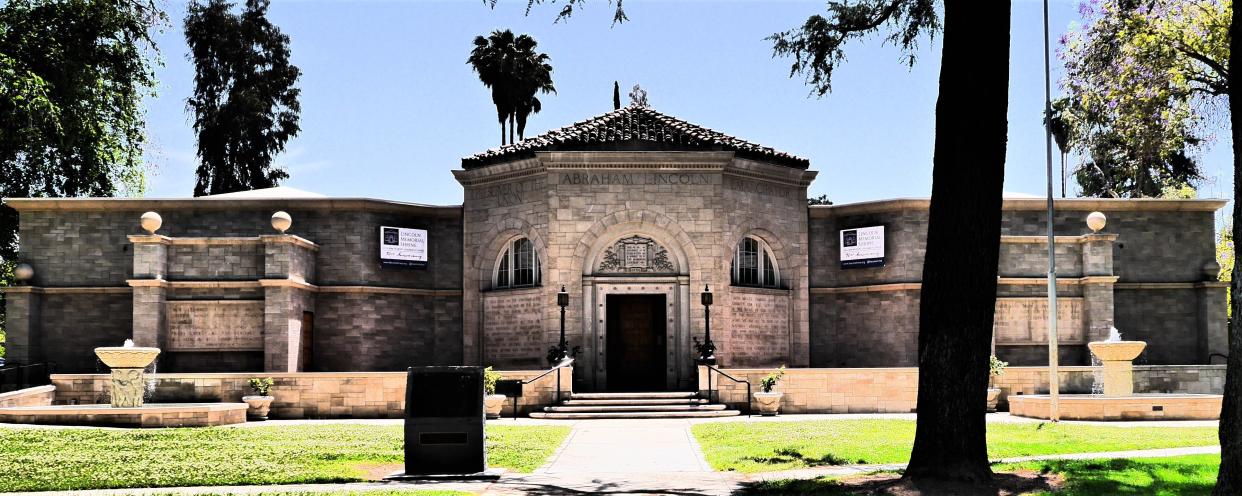
- Oops!Something went wrong.Please try again later.
As a researcher for the articles I write, I found an interesting but unknown quote from President Abraham Lincoln.
It was perhaps uttered after a speech he gave in Peoria, Illinois, on Oct. 16, 1854. After explaining his concerns about the Kansas-Nebraska Act to a crowd of Peorians, Lincoln turned to another Peorian and may have said,
“You know, if I become president, I would like to have a memorial shrine,” the tall man stated. “Perhaps the small burg of Redlands, California. I understand they will be a booming city someday.”
And sure enough, the future president was correct. Redlands was incorporated in the late 1880s, and the Lincoln Memorial Shrine was dedicated in 1932 by Robert Watchorn, a local philanthropist.
According to Docent Jim, “This facility has the largest collection of President Lincoln memorabilia west of the Mississippi.”
“Hmm,” I replied. That seemed a bit far-fetched, so I excused myself and turned my back while googling this and that on my phone.
Docent Jim had been correct.
I recently visited the Lincoln Memorial Shrine in the city of Redlands. Sounded interesting, and being a fan of President Lincoln, I thought the short trip to the city named after the color of the adobe soil found in abundance would be an opportunity to pay a bit of homage to a great American hero.
“This place was very special to the founder, Robert Watchorn,” Docent Jim said. “He was a true admirer of the 16th president. So much so that he and his wife donated the land and finances to build the shrine in memory of the son, Ewart, who died at 25 in 1921.”
Why would a United States President conjure up such respect from a man born in near poverty in the small town of Alfreton, England, in 1858?
To help support his family, Watchorn worked the coal mines and then immigrated to America in 1880, relocating to Pennsylvania. There he again worked in coal mines but knew that education was the way out of his sort of financial poverty.
There was this feeling Watchorn had that if he applied himself, studied, and worked hard, he could climb up and out of the mines, literally.
He found that President Lincoln had once addressed this feeling in America as a wonderful phenomenon — "the right to rise."
And rise, he did.
He started night schools for the miners to improve their lives. He joined various unions, became involved in many actions to improve the conditions of the miners, and was paramount in ending the horrible child labor in the state of Pennsylvania.
For his efforts, Watchorn was recognized as the go-to guy for many things and was tapped by Pennsylvania Governor Pattison to be the Inspector of Factories and Mines in 1891. Later, Watchorn would serve positions in government under President Roosevelt, who appointed him Commissioner of Immigration at Ellis Island in New York in 1905.
In 1909, Watchorn joined the Union Oil Company and made a fortune after striking out on his own and starting the Watchorn Oil and Gas Company.
His was the true rags to riches story.
But he was one to spread his wealth around and not hoard it like some tight-wad Mr. Scrooge.
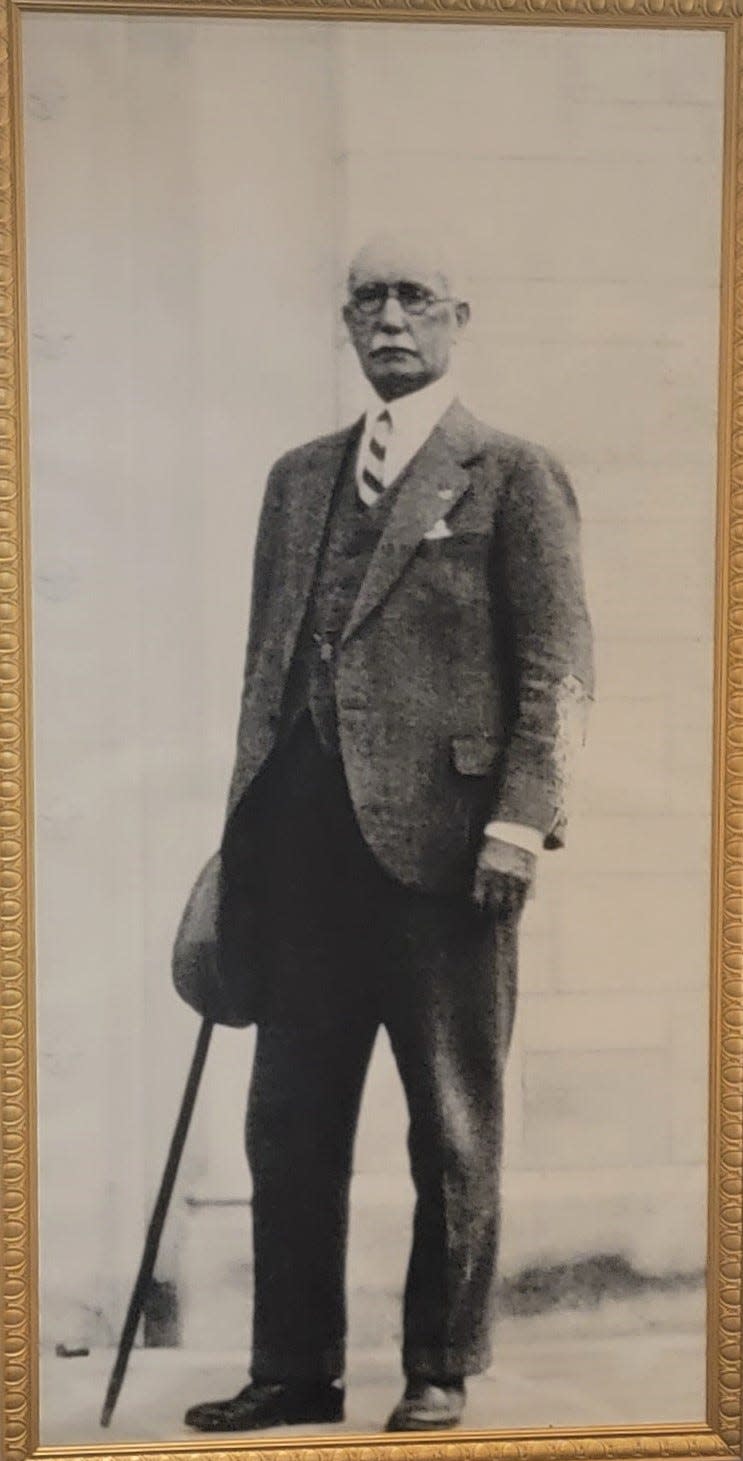
In fact, during his lifetime, he donated chimes to churches in Los Angeles, Redlands, and La Crescenta. He built housing and parks in his hometown of Alfreton in England and paid for the Watchorn Hall at the University of Redlands, to name a few of the charitable things he did during his life.
He and his wife, Alma, had visited Redlands and fallen in love with the Southern California community. They built a winter home there in the 1920s.
His passion for President Lincoln never let up. He once summed up his feelings for this man, who had also grown up in abject poverty and, due to personal fortitude, rose to be the president of the United States.
“He is one the finest spirits that ever came into the world, and he turned the currents of freedom into the souls of millions of fellow men.”
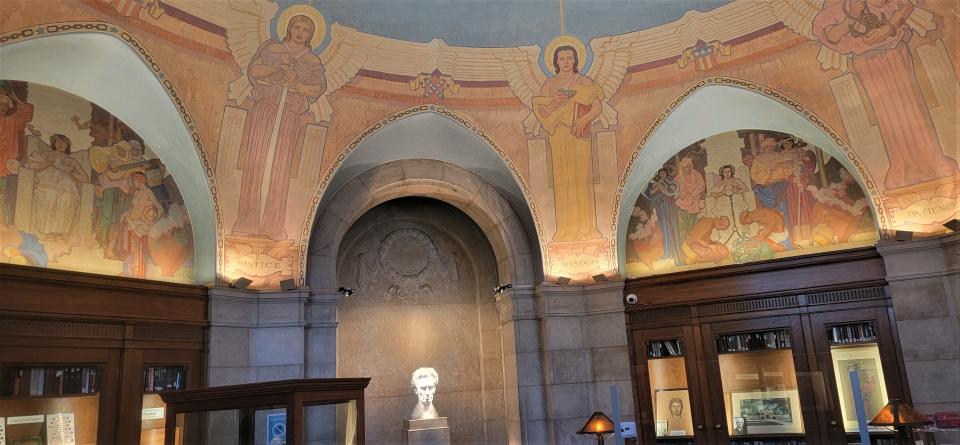
When I first entered the memorial, I was taken aback by the grandeur of the octagon-shaped rotunda. The structure built in 1932 is not terribly large but it seemed enormous. Tall, rounded ceilings with beautifully painted murals cover every inch of the building.
“You know,” Docent Jim started. “That is canvas the murals are painted on and not the walls themselves.”
I did not know that.
“In fact, the artist, Dean Cornwell was given the measurements and he painted them in his studio and then came here and affixed them to the walls. They fit perfectly.”
Unbelievable talent, I mused while looking up at the intricate designs and masterful brush strokes the artist used to paint the larger-than-life eight female figures gracing the walls of the rotunda.
Each one appeared to be an angel of virtue with their wings touching looking down at me.
I had a sudden stirring I should be going to church soon.
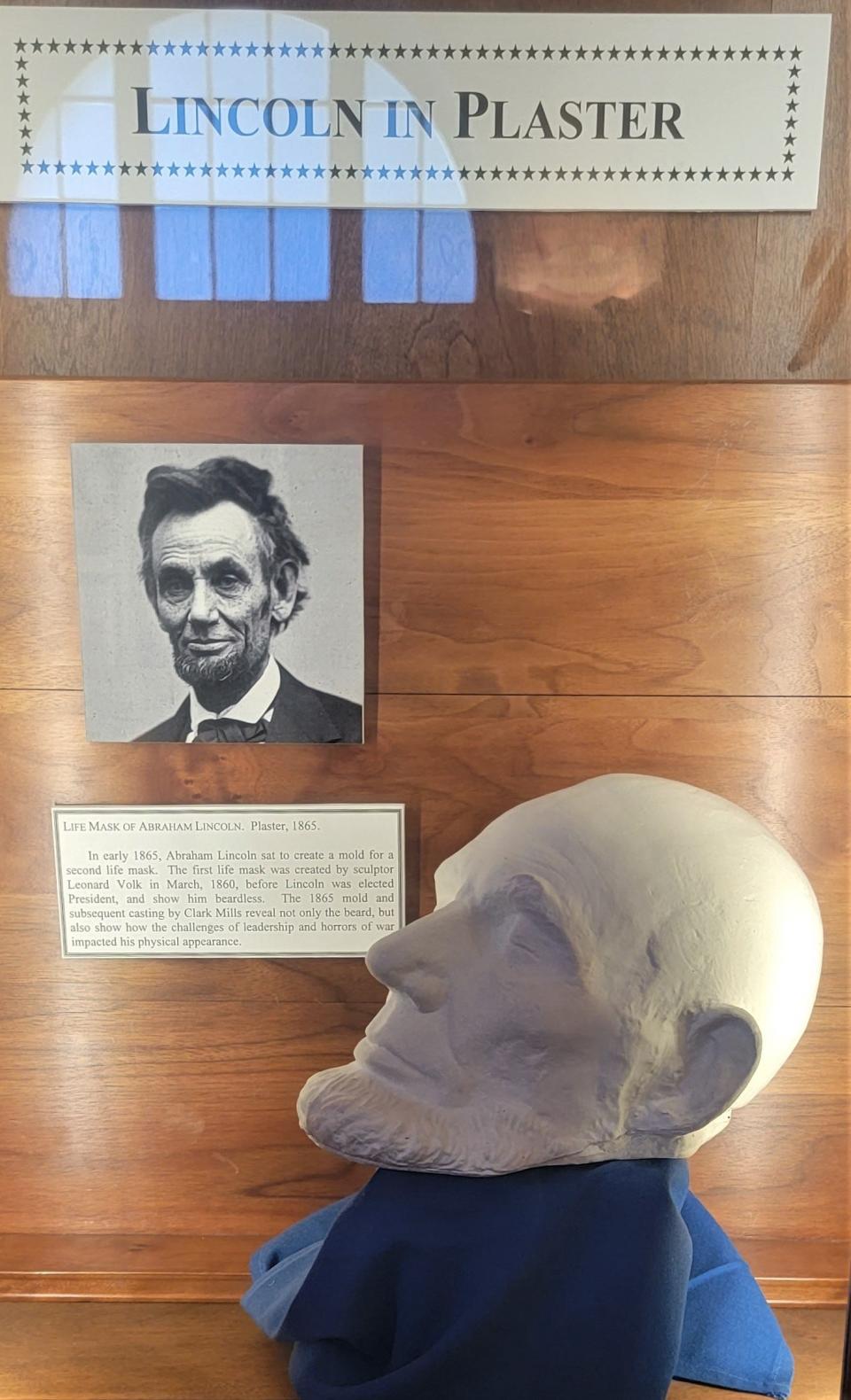
One main piece of art that grabs a visitor’s attention when entering the rotunda is the marble bust of President Lincoln in an alcove opposite the double door entry.
The bust was created by master artist George Grey Barnard and was officially gifted to the city of Redlands in 1931. Barnard used what the ancient Romans called Luna marble — the same marble used by Michelangelo.
That is impressive.
To me, and I am no art expert, the bust has the appearance of strength, thoughtfulness and fragility wrapped up in Lincoln’s stoic stare.
“Would you like a tour?” Docent Jim asked.
A tour we went, starting off in the west wing of the memorial.
In 1932 the rotunda was built and in 1937 two additions were built on the west and east side. They were outdoor covered areas with sitting benches, fountains, and gardens.
Watchorn had always wanted two permanent wings to be built alongside the rotunda but with the Great Depression and World War II looming, his finances were needed elsewhere.
In 1998, through the donations of locals and others nationwide, the two wings were completed, allowing the memorial to expand to thirty-five hundred square feet.
The west wing sounds very presidential, and contains the history of the Watchorn family, information concerning the construction of the memorial, and other interesting items. And one of those items happens to be an original Norman Rockwell painting entitled, Thoughts on Peace on Lincoln’s Birthday.
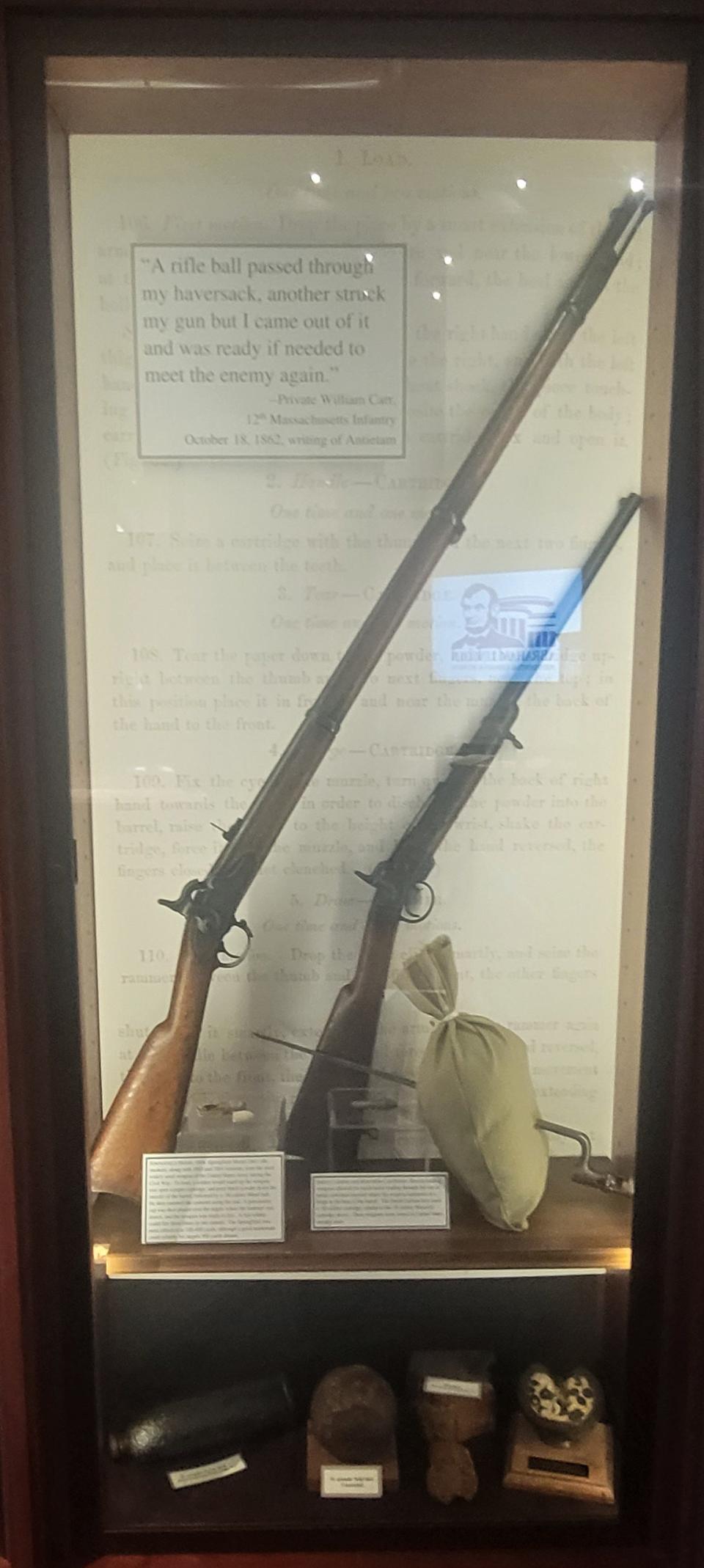
The 1945 painting depicts a wounded World War II service member holding a biography of Abraham Lincoln as though he is pondering what the president had meant about freedom for all and the sacrifices it took or would take to hold onto that freedom.
It is a piece of genuine Americana, with images of everyday Americans surrounding the soldier but not a part of him. Each, as though looking for a brighter and more peaceful future.
In the upper left-hand corner of the painting is the image of Lincoln himself.
Docent Jim noticed I was staring at the painting longer than my usual patience would allow.
“I believe it is priceless,” he said.
“Freedom usually is,” I replied.
After enjoying an enjoyable time in the west wing, we moved through the rotunda and entered the east wing, where Lincoln material is located.
My eyes were drawn to a huge multi-colored quilt stretched over a large glass-encased table.
The War Quilt.
It seems during the Civil War; women would gather and make quilts for the soldiers to use during those cold nights on the battlefields. Each square was made by a different woman who would then sign the section. After all the sections were done, the quilt would be sewn together, and soldiers would receive them for the warmth they provided and for the memory of home where each soldier came from.
It was very touching to gaze upon this piece of fabric over a hundred and sixty years old and imagine the hours and the fingers that created this quilt.
There are displays of Civil War weapons, kits the soldiers used, papers written by President Lincoln, photographs of President Lincoln with various officers during the Civil War.
One item that is on display is the life mask of the president.
I had heard of death masks but not a life mask.
“It was quite common,” Docent Jim said.
![Dedication monument to the Watchorn Family - original donors of ]The Lincoln Memorial Shrine in Redlands.](https://s.yimg.com/ny/api/res/1.2/weO8J4_6JYHpHM8.ljkeHQ--/YXBwaWQ9aGlnaGxhbmRlcjt3PTk2MA--/https://media.zenfs.com/en/victorville-daily-press/5e8a49ce1907ac17c76dc00f57d4573d)
Nope, I will not have plaster plastered on my mug until it dries.
Lincoln was growing more stoic with every step I took through this museum.
It turns out that what is on display is only a small sampling.
“There is so much more that we don’t have the room to display it all at once,” Docent Jim told me. “We keep it in storage and change out things on a routine basis.”
As I left the building, my understanding of what the Watchorn family had given not just to Redlands but to all of us was massive.
Truly historical.
Email John R. Beyer at beyersbyways@gmail.com.
This article originally appeared on Victorville Daily Press: The Lincoln Memorial Shrine in Redlands memorializes 16th president

